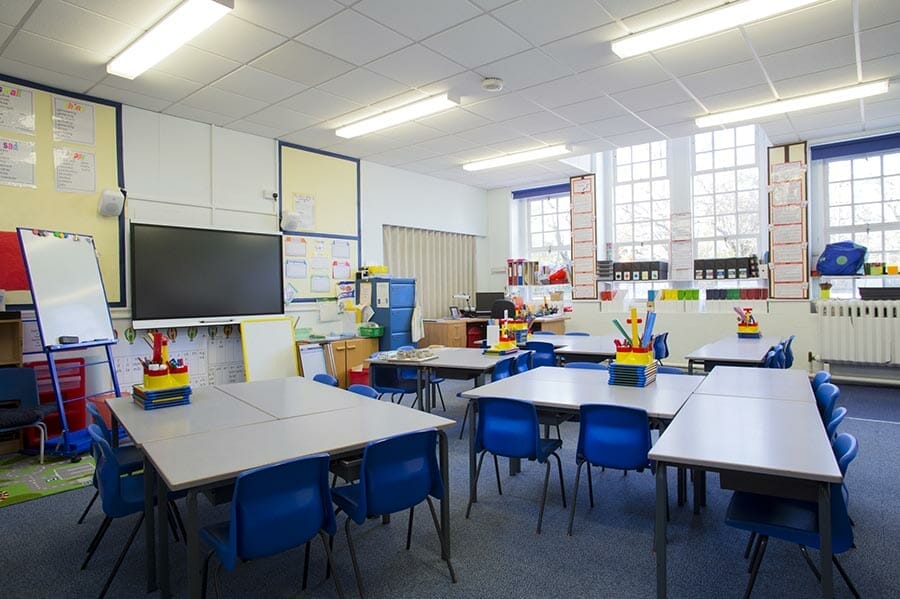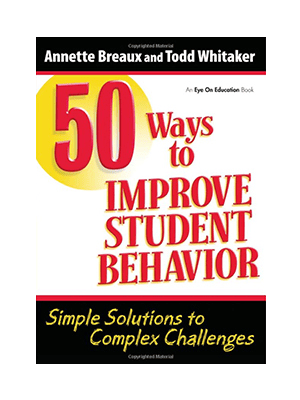| Is too much stuff draining you? As you look around your classroom, do you feel that there is a place for everything? Or do you feel that just beneath the surface (or behind the closet door or inside the desk drawer) there is just a bit too much stuff cluttering up your space? Get your clutter under control, and your attitude and health just may improve, too. |
Having too much stuff can not only drain and frustrate you, it can make it difficult to get things done. If we tend to feel anxious or overwhelmed at school, clutter can make it worse. Just the sight of clutter can remind us of unfinished tasks or make us feel less in control of our surroundings. We may find it hard to relax if our eyes never fall on a blank wall or an uncluttered surface. If we live with a sense of scarcity due to ongoing budget cuts, we might worry about throwing anything away, which only makes the clutter worse. Even if our clutter doesn’t bother us, it may impact our students.
Both mental health professionals and self-prescribed “minimalists” (people who aspire to live with less) believe that reducing clutter and the amount of “stuff” we live with can help us feel less stressed. Minimalists believe that when we remove what isn’t adding value in our lives, we make room for the stuff that is. Let’s look at four specific decluttering strategies from “The Minimalists Rulebook” that seem perfectly geared for classroom teachers. Here’s to more calm and less stuff!
Stress Less: Four Rules for Clearing Unwanted Clutter
Rule # 1: Let Go of “Just in Case”
The authors insist that “just in case” are the three most dangerous words in the English language. We hold onto things because we think we might need them sometime in the future. I think the reason I (and so many teachers I know) tend to do this is because we work from a mindset of scarcity. Years of budget cuts means less of everything. Sooner or later, this sense of scarcity creeps into even our most basic choices. Rather than throwing out the old teaching guides or unused craft items, we think, “maybe someday I’ll need this” and the piles keep stacking up.
The most important thing we can do is declutter our classrooms (and our lives) from a mindset of enough. We need to organize our rooms with the present in mind: if the things we have are not routinely used or do not routinely bring real value to our teaching, we need to trust ourselves to let these things go. If we have a lot of just-in-case stuff, we spend too much precious energy moving and reorganizing these items each school year. The next time you come across an item you haven’t used in the last 6 months (or more), ask yourself if it is worth your time and mental energy to keep storing it. Think: Would it cost less, financially and emotionally, to get rid of it now and buy or borrow later if I need it?
Rule # 2: Wait for It
With the rise in online shopping, especially during the pandemic, it is easier than ever to buy what we want, when we want it. With new technology rollouts, it’s also easy to get pulled into the upgrade cycle, even if our old products still work well. The “Wait for It” rule, aka The 30/30 Rule, is simple: If an item is more than $30, wait 30 hours to purchase it. Give yourself time to consider if the new item will really add value to your classroom or your life. You may consider setting a higher threshold, too. For example, if an item is more than $100, can you wait two or four weeks before you buy? If you do end up making the purchase, try to remove one item at the same time to keep your “stuff” and your space balanced.
Rule # 3: Sometimes, “One Person’s Junk is…Another Person’s Junk”
When we spend time or money creating or accumulating classroom materials, we believe they have value, even if that value depreciates over time. So, when the time comes to get rid of them, we often spend an unreasonable amount energy trying sell them or finding a “grateful recipient.” We think: Surely someone else must want this set of paperback books for their students that I purchased 25 years ago! I remember as a first-year teacher, the retiring teacher before me left 30 years’ worth of old materials behind, telling me it was his “gift” to me; I spent days sorting closets and throwing out moldy books and photocopies.
The best way to avoid this “trap” is to set a deadline when trying to sell or give away items. Whether you post your item on Facebook Marketplace, Ebay, or in the teachers’ lounge, give yourself 30 days to get rid of the item. If at the end of the month no one wants the item, find a donation site to drop it and let yourself be free. Most importantly, avoid pushing unwanted items on other teachers. Don’t make your items a burden for someone else.
Rule #4: The Spontaneous Combustion Rule
This might be my favorite rule. It starts with a simple question: If the item in question were to suddenly burst into flames, would you feel relieved? If so, give yourself permission to get rid of it. This gets back to our sense of scarcity: As teachers, we often keep things (hand-me-down lesson plans and craft supplies, once-stunning student projects from years ago) because we feel a sense of obligation or perhaps a sense of guilt. We think: Maybe I shouldn’t get rid of this because who knows if I will be able to replace it? But if the things we have burden us or if the thought of having to sort those materials or find new storage places for them feels overwhelming, it’s important to let them go. The authors of “The Minimalist Rulebook” tell the story of friend who felt overwhelmed by a hoard of articles he had stored in his phone that he intended to read at some point. When they asked him how he would feel if the articles suddenly disappeared, he realized what he needed to do: He deleted the entire file on the spot as his friends cheered him on.
Shannon Kaiser, author of “Find Your Happy: An Inspirational Guide to Living Life to Its Fullest” provides great insight about the link between decluttering and happiness. She says, “the importance of downsizing is significant. Whenever you take a stand to unclutter your life… you send a clear message to the universe that you are willing to remove unwanted things. It may seem silly, but when you clear out space you have more room to play, laugh, love and live.” She’s right. Most of us will find that we feel more peaceful and more present when we have less to look at as we enter a room – the same is true for our students. Now, I try to choose two or three items to be the focal point, and I let go of the little things that don’t make an immediate impact.
Resource: Millburn, J. The minimalist rulebook: 16 rules for living with less. Theminimalists.com.
























